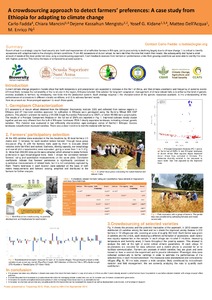A crowdsourcing approach to detect farmers’ preferences: evidences from Ethiopia for adapting to climate change
Climate change is severely affecting production systems all over Africa. Ethiopia will face an increase in temperature and changes in rainfall patterns. One solution for long term management
of climate related risks is to introduce new traits into production systems. We present an approach to quickly deliver to farmers a selected number of preferred accessions of durum wheat using a crowdsourcing approach. After having completed a phenotypic and genotypic characterisation of 400 accessions of Ethiopian landraces and asked farmers to evaluate them, we distributed seeds of preferred varieties to a large number of farmers using a crowdsourcing approach. In two sites representing different agroecological zones, we distributed 20 superior varieties and
one check, an improved variety very common in both areas to 200 farmers in 12 villages per site, covering an area of roughly 350 km
2. We repeated the experiment for 2 years. Each farmer was given
3 blind varieties and the check, each variety being equally represented in the sample. In addition, in each village we included 2 i-buttons, measuring temperature and humidity every 3 hours throughout the growing season. This allowed to analyse the data on critical climatic parameters. Results clearly indicate farmers’ preferences: a) Landraces were preferred over improved varieties
for their multiple uses; b) By considering farmers as citizen scientists, we have a better understanding of the criteria farmers use to select their preferred varieties (in our case straw and grain yield, drought tolerance, uniformity, long and dense spikes).
In conclusion:
• This process has been very effective in quickly disseminating seeds that match farmers’ needs.
After 2 years several hundred farmers can use better adapted material.
• It shows the potential of landraces to provide immediate option for managing climate related
risks and calls for broader use of material conserved in gene banks.
• It indicates the need to strengthen local seed systems to better manage these resources.
• It indicates how farmers can provide very valuable scientific information that can be translated
into research as well as development potential in other areas of research.

